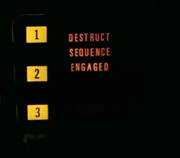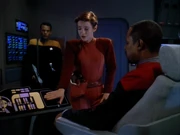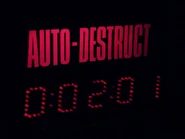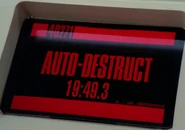No edit summary |
|||
| Line 5: | Line 5: | ||
The auto-destruct system aboard {{Class|Intrepid}} starships could not be activated if the [[secondary command processor]]s were damaged. ({{VOY|Basics, Part I}}) |
The auto-destruct system aboard {{Class|Intrepid}} starships could not be activated if the [[secondary command processor]]s were damaged. ({{VOY|Basics, Part I}}) |
||
| − | The auto-destruct system aboard {{Class|Sovereign}} starships could be activated even if the [[computer|main computer]] |
+ | The auto-destruct system aboard {{Class|Sovereign}} starships could be activated even if the [[computer|main computer]] was locked out and encrypted. ({{film|8}}) |
On [[Starfleet]] vessels, the activation sequence varied from class to class, but usually required authorization from the [[captain]] and/or [[senior officer]]s, with the use of [[command authorization code]]s in most cases. Once the countdown was activated, the computer gave audio warnings, usually with an interval of ten seconds until the last ten seconds that were counted down in intervals of a second, and displayed graphics on [[viewscreen]]s. There was also an option for a silent countdown, which gave no further audio warnings once the auto-destruct sequence was engaged, preventing boarders from learning the ship was about to explode. ({{film|8}}; {{VOY|Deadlock}}) |
On [[Starfleet]] vessels, the activation sequence varied from class to class, but usually required authorization from the [[captain]] and/or [[senior officer]]s, with the use of [[command authorization code]]s in most cases. Once the countdown was activated, the computer gave audio warnings, usually with an interval of ten seconds until the last ten seconds that were counted down in intervals of a second, and displayed graphics on [[viewscreen]]s. There was also an option for a silent countdown, which gave no further audio warnings once the auto-destruct sequence was engaged, preventing boarders from learning the ship was about to explode. ({{film|8}}; {{VOY|Deadlock}}) |
||
Revision as of 17:48, 12 September 2013
The Constitution-class Enterprise self destructs
The auto-destruct system (also known as self-destruct or destruct sequence) was a starship system that allowed the total destruction of the vessel. This was typically activated as a last resort, usually to prevent a ship from falling into enemy hands.
The auto-destruct system aboard Intrepid-class starships could not be activated if the secondary command processors were damaged. (VOY: "Basics, Part I")
The auto-destruct system aboard Sovereign-class starships could be activated even if the main computer was locked out and encrypted. (Star Trek: First Contact)
On Starfleet vessels, the activation sequence varied from class to class, but usually required authorization from the captain and/or senior officers, with the use of command authorization codes in most cases. Once the countdown was activated, the computer gave audio warnings, usually with an interval of ten seconds until the last ten seconds that were counted down in intervals of a second, and displayed graphics on viewscreens. There was also an option for a silent countdown, which gave no further audio warnings once the auto-destruct sequence was engaged, preventing boarders from learning the ship was about to explode. (Star Trek: First Contact; VOY: "Deadlock")
Known sequences
Constitution-class

Destruct sequence engaged
On Constitution-class starships, three senior officers were required to initiate the destruct sequence, using the following, concurrent codes.
Each officer would state their name, rank and corresponding code:
- "Destruct sequence 1, code 1-1 A."
- "Destruct sequence 2, code 1-1 A-2B."
- "Destruct sequence 3, code 1 B-2B-3."
The computer would then reply:
- "Destruct sequence completed and engaged. Awaiting final code for one-minute countdown."
The commanding officer would then state:
- "Code zero zero zero. Destruct. Zero."
The default setting was for a one-minute countdown, but this could be altered during the sequence initiation. The sequence could be aborted at any time up until T-minus five seconds by the captain or highest-ranking officer, with the code "Abort destruct sequence, code 1-2-3-continuity." (Star Trek III: The Search for Spock; TOS: "Let That Be Your Last Battlefield")
Galaxy-class
On Galaxy-class starships, the commanding and executive officers activated the destruct sequence from main engineering. Both would provide palm print identification, and order the auto-destruct with both officers having to agree. This could be aborted from the bridge by voice recognition and palm print identification of both of the same officers.
In "Let That Be Your Last Battlefield", Kirk stated that the destruct order could not be countermanded once the countdown reached T minus 5. This restriction did not apply to the Enterprise-D, however, where the destruct order was aborted with one second to spare.
Defiant-class

Activating the USS Defiant's auto-destruct sequence
The Defiant-class sequence was activated from the bridge, requiring two officers' consent, and hand print verification to activate and abort. (DS9: "The Adversary")
Intrepid-class
Aboard the Intrepid-class, auto-destruct required the captain's sole authorization. This class had the option of ordering a silent countdown - a single voice prompt would occur at the commencement of the sequence, with no further audio warnings made. (VOY: "Deadlock", "Dreadnought") The authorization proceeded as follows:
- "Janeway to computer: initiate the self-destruct sequence. Authorization: Janeway Pi 1-1-0. Set at (desired time interval followed by option {e.g. "mute voice warnings"}), enable."
The computer would reply the following: "Warning: Self-Destruct Sequence has been initiated; Warp Core overload in (given time interval and, if commanded to mute voice warnings, {"there will be no further audio warnings."}).
If the starship's secondary command processors were offline, the auto-destruct sequence could not be completed. (VOY: "Basics, Part I")
Sovereign-class
The Sovereign-class returned to the "three-officer" authorization method. Each would state name and rank, confirming the sequence, and giving their authorization code. The senior officer would then select the destruct sequence type, sequence delay, and whether a silent countdown would be initiated. The sequence would begin upon use of the command "Enable". In the case of the Enterprise-E, the sequence was as follows:
- "Computer, begin auto-destruct sequence, authorization Picard 4-7 Alpha Tango."
- "Computer, Commander Beverly Crusher. Confirm auto-destruct sequence, authorization Crusher 2-2 Beta Charlie."
- "Computer, Lieutenant Commander Worf. Confirm auto-destruct sequence, authorization Worf 3-7 Gamma Echo."
- (The computer would ask for the final code to start the sequence.)
- "This is Captain Jean-Luc Picard. Destruct sequence Alpha-One. 15 minutes, silent countdown. Enable" (time and silent countdown mode are optional).
The auto-destruct apparently need not be deactivated by the ship's captain, as Lieutenant Commander Data was able to deactivate the auto-destruct sequence by himself. (Star Trek: First Contact)
The ship's captain was able to activate the "Omega" option for the auto-destruct on his own authorization without the need of any other officers. The captain would order the computer to stand-by to initiate the Omega-destruct option with the use of an authorization code. In the case of the Enterprise-E, the order would proceed as:
- "Computer, stand-by auto-destruct sequence Omega. Recognize voice pattern Jean-Luc Picard, authorization Alpha-Alpha 3-0-5."
If the ship was significantly damaged, the auto-destruct system could be rendered inoperable. (Star Trek Nemesis)
Methods
James T. Kirk and his crew witnessed the self-destruction of an Orion scout ship
On most Federation ships, the destruct sequence used one of two methods of completion (both could be installed to allow for redundancy).
The first used the ship's matter and antimatter fuel supplies, combining them in an unmoderated reaction with the resultant annihilation reaction being more than enough to obliterate the entire vessel, much like a warp core breach. (Star Trek: The Next Generation Technical Manual)
Klingon vessels, like the D7 class, were equipped with this self-destruct method that caused a containment failure within the warp core. (VOY: "Prophecy")
In the second, explosive charges placed at key points throughout the vessel would ensure complete destruction. It was approximately half as powerful as the former method (an estimated yield of one thousand and five hundred photon torpedoes, respectively). (Star Trek: The Next Generation Technical Manual)
Sometimes a self-destruct sequence would result in a chain reaction of explosions, as in the case of Constitution-class starships, while in others it resulted in one massive explosion, as in the case of the Orion scout ship encountered by James T. Kirk and his crew. (Star Trek III: The Search for Spock; TOS: "Journey to Babel")
23rd century Romulan vessel used "old style" atomic weapons in their self-destruct system which were not integrated into the ship itself. These weapons could be removed and jettisoned into space as mines. (TOS: "Balance of Terror")
A Borg vessel's self-destruct mechanism forced the ship's power grid to feed back on itself, forcing an explosion that destroyed the ship. Lieutenant Commander Data was able to trigger such a destruction while being linked to the collective consciousness of the Borg ship that threatened Earth in 2367. The Borg Queen ordered the self destruction of several Borg ships that carried drones linked to Unimatrix Zero as well as a Borg tactical cube that had Captain Kathryn Janeway, Lieutenant Commander Tuvok and Lieutenant B'Elanna Torres aboard. (TNG: "The Best of Both Worlds, Part II"; VOY: "Unimatrix Zero, Part II")
When a Borg vessel was critically damaged, all of its vital technology, such as the transwarp coils, self-destructed to prevent their use by other species. (VOY: "Dark Frontier")
See also
Evidence
- See: computer log



